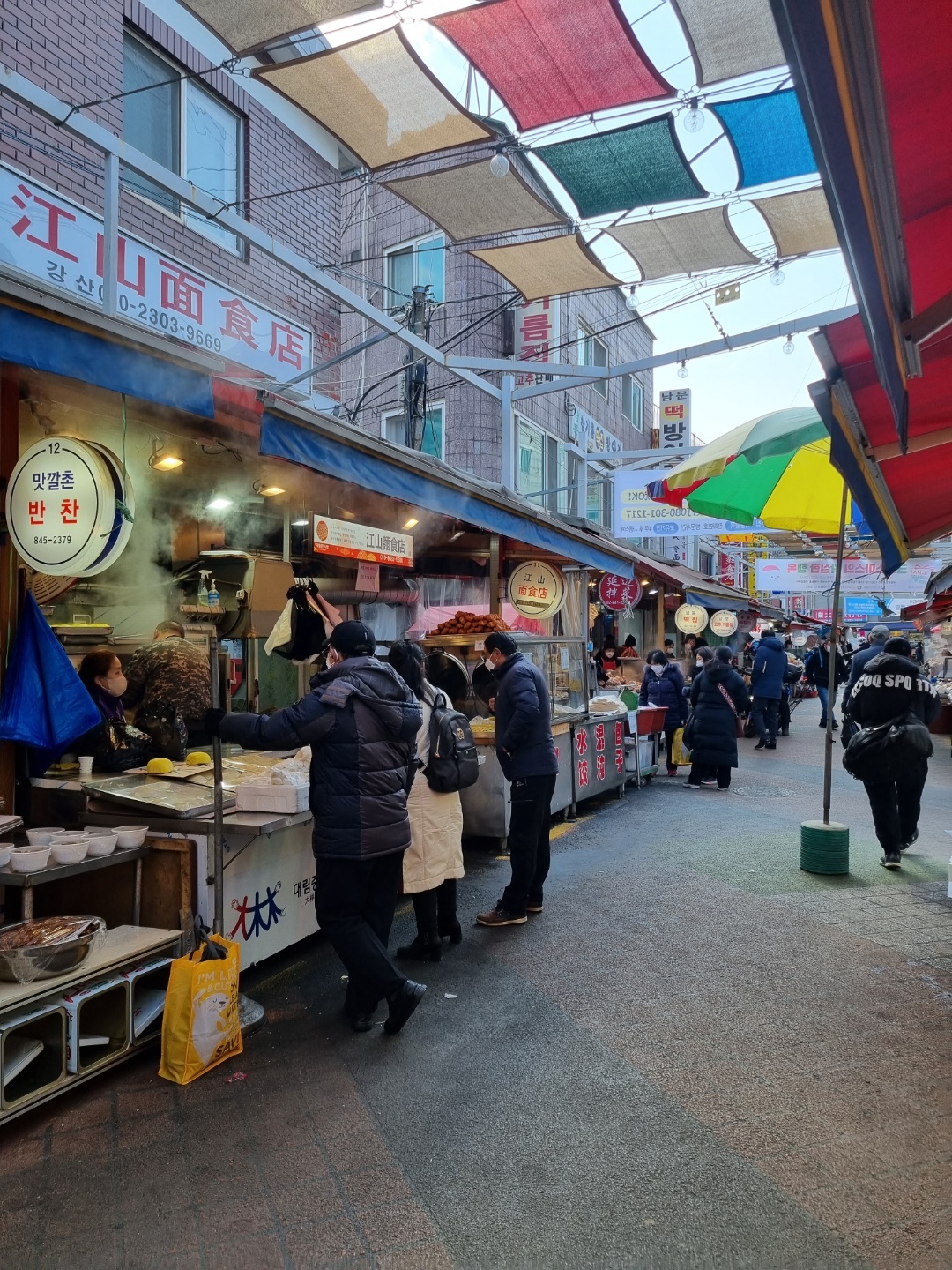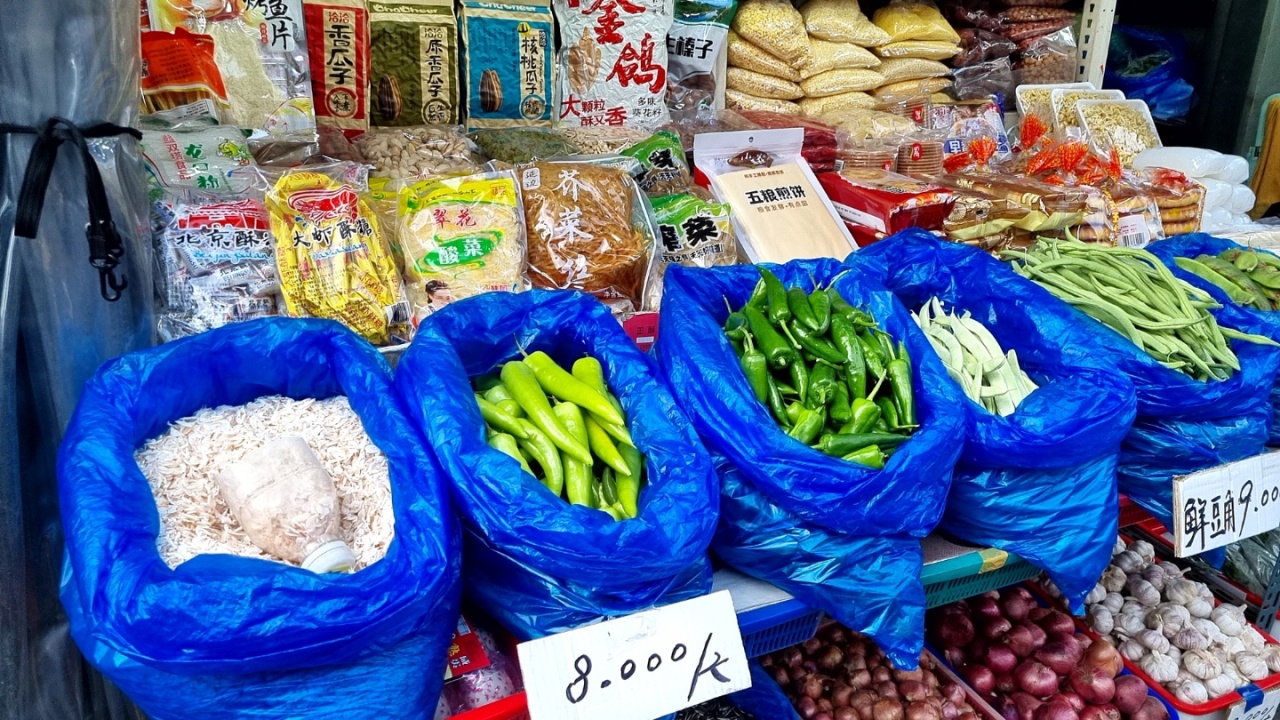The following is part of Seoul Subway Stories, a Korea Herald series exploring the city’s subway stations and surrounding areas. -- Ed. 
People buy freshly baked bread and rice cake at Daerim Central Market in Yeongdeungpo-gu, Seoul. (The Korea Herald)
An exotic scene created by the mixture of Korean and Chinese culture unfolds when walking out of Exit 12 at Daerim Station on subway lines No. 2 and 7 in southwestern Seoul.
Large restaurants with colorful signs written in Chinese sell hot pot and lamb skewers, dishes that have become increasingly popular among Koreans in recent years. Small shops fill their shelves with Chinese condiments, pantry staples and snacks.
People on the street speak Mandarin, Korean or Korean with the dialect of Yanbian, which has the largest ethnic Korean population in China.
Often dubbed as a little Chinatown in Seoul, this neighborhood tells a story about the complex relationship between Korean residents and Chinese of Korean descent.
Walking along the street packed with shops, the entrance of Daerim Central Market appears. A wide range of street foods, from fried dough to several types of tofu, are available for between 1,000 won ($0.83) and 2,000 won. The Southeast Asian fruit durian, which is not commonly sold at Korean stores, can be easily found in the market.
Zheng Yue, 35, an interpreter who came from China’s northernmost province Heilongjiang, says visiting Daerim feels like coming home.
“Daerim-dong is very similar to a street in real China. I feel friendly there because it is the only place that I can freely speak in Mandarin,” she said. Handmade noodle shops, Sichuan cuisine restaurants and grocery stores are cures for homesickness, she said.
Kim Gwang-yong, who was naturalized as a Korean citizen in 2006, runs a bakery in the market, selling Chinese steamed buns and donuts. He hasn’t raised the price of a Mandarin roll from 500 won since he opened the store in 2013.
“There are still many people looking for day labor jobs among the customers who come to the store. I want them to eat heartily even if they fail to find a place to work for the day,” he said. “You can’t buy booze with 500 won but you can get a bun.”
Before Daerim became a major Chinese enclave, home to the highest Korean-Chinese and Chinese populations in the country, neighboring Garibong-dong was the place where many Chinese immigrants settled in the early 1990s.
At the time, Korea imported foreign workers, most of whom were Korean Chinese. These workers were mostly drawn from the unemployed population that emerged during China’s post-socialist transition, according to Park Woo, an assistant liberal arts professor at Hansung University who has conducted participant observation studies on the Chinese community in Korea for over 10 years.
Immigrants who came to Korea in search of work gathered and lived in Garibong, a 15-minute drive away from Daerim, because the district was located adjacent to the Guro Industrial Complex, which was at the heart of Korea’s rapid economic growth. The neighborhood offered job opportunities to foreigners and cheap rents.
When Garibong was designated as a redevelopment area in 2003, people started to move to Daerim.
Currently, a total of 10,324 Chinese and Korean Chinese people live in Daerim, approximately one quarter of the total population in the area.
Yet, among the greater population of Seoul, Daerim is seen as a place that most people don’t desire to visit.
“I’m curious about the Chinese food they have. But I’m concerned about security issues there -– it feels a little creepy, honestly,” said a 56-year-old housewife who declined to be named.
Areas that have convenient access to public transport with two subway lines normally have high property prices, but the average price of an apartment in the area, however, is much lower compared to other districts in Seoul due to low demand.
Daerim is known nationwide for its role in the Korean action comedy film “Midnight Runners” (2017), which starred Park Seo-joon and Kang Ha-neul. In the film, the neighborhood was depicted as a base for a villain.
Other films, such as “The Yellow Sea” (2010) and “The Outlaws” (2017), have also shed light on the dark side of criminal gangs made up of Korean Chinese people.
“Midnight Runners” depicted violence in the town with graphic scenes and the line, “There are a lot of Chinese here, so there are often knife attacks at night.”
The production company of the hit film, which sold about 5.6 million tickets, received a court recommendation to apologize to the Korean Chinese community in 2020 after 62 Korean Chinese people filed a suit against the firm for indemnity.
But the court ruling didn’t stop anti-Korean Chinese sentiment. It further reignited after a stabbing spree occurred in Daerim in 2021. A Korean Chinese man in his 50s, who stabbed a woman and her boyfriend to death, was sentenced to life imprisonment. The victims were also Korean Chinese.
Foreign and local residents jointly launched a patrol team and anti-violence campaign for the safer neighborhood.
But do Chinese people really commit more crimes than other foreign residents?
The number of foreign nationals who committed crimes stood at 35,390, or 2.4 percent of a total of 1,494,421 criminals, in 2020, according to the Korean National Police Agency.

Chinese vegetables and condiments are displayed at Daerim Central Market in Yeongdeungpo-gu, Seoul. (The Korea Herald)
Of them, Chinese nationals accounted for 48 percent, or 17,116. The figure is nearly on par with the proportion of Chinese population living in the country – 44 percent.
A report released by the Korea Institute of Criminology shows that there were 197 crimes committed by foreigners in Daerim out of 1,225 cases occurred from July 2018 to June 2019. Except murder, the rates of other kinds of crimes by Korean nationals were higher.
“It seems that heterogeneous characteristics, such as the tendency to use a weapon when enacting violence, have led to a perception of risk related to crimes committed by foreigners,” the report said.
Chronic discrimination against blue-collar workers and hatred against people from Yanbian have contributed to an overall sarcastic perspective on Daerim, Hansung University professor Park said.
“Since these fellow Koreans are seen as foreign workers within a society that already has a hateful sentiment toward them that has long existed, I think that the current view on Daerim is not only triggered by Korean Chinese people,” he added.
“Daerim is a part of Seoul, a community that was built together by indigenous Koreans and Korean immigrants, as well as North Korean defectors and migrants of various ethnicities.”
Pak Noja, a Russian-born Korean academic and a professor at the Oslo University in Norway, pointed out that Korean people tend to discriminate the language and daily behaviors of Korean Chinese that are deemed different from the Korean “standard.”
Smoking and loud chanting, which are mainly seen as symbols of the low-wage working class, are also subject to contempt.
“The chronic problems of Korean society, such as the absence of an attitude to accept ‘difference’ and a pattern of class discrimination, are what produce hateful feelings for fellow Koreans,” he said in a column published last April in daily newspaper Hankyoreh.
By Park Han-na (
hnpark@heraldcorp.com)







